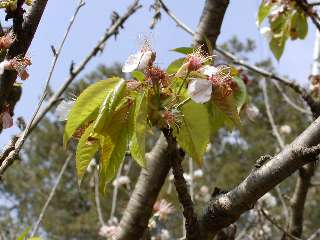Relatives
Cerasus avium (L.) Moench - Sweet cherry, mazzard.
Taxonomic position.
Family Rosaceae Juss. genus Cerasus Hill.Synonyms.
Prunus avium L.Morphology and biology.
Tree up to 23(35) m tall, producing no rootstock, with an oviform crown. Leaves are up to 16 cm long and 8 cm wide, oblong-ovate or elliptic, abruptly tapered at the top into a sharp point, biserrate along the edge, with denticles sharpened into a cartilaginous point, naked from above and slightly pilose from below over the whole surface or only along the veins. Petioles have two glandules in the upper part. Stipules are linear, adenodentate. Flowers, grouped into oliganthous umbels, are set on naked pedicels 2.5-6 cm long. Inflorescences have no leaves at the base. Flowers are white. Hypanthium is cup-shaped. Sepals are obtuse, usually smooth-edged, deflected. Fruits of wild plants are about 1 cm in diameter, globular, ranging in color from dark-red to almost black, having for the most part a bitter or, quite infrequently, sweet flavor, with juicy sweet pulp. Stones are smooth, globular or ovoid. Entomophilous. Ornitochore. Blossoms in April-May, bears fruit in June. 2n=16, sometimes 17, 18.Distribution.
Moldova, Ukraine (south-western and southern parts, southern Crimea), Caucasus, Europe (Central and Southern), Turkey (north), Iran (north), Africa (north-west).Ecology.
Mesophyte. Photophilous. It grows as solitary trees or in small groups, more often as a minor admixture to broad-leaved forests (oak, hornbeam-oak, beech or beech-hornbeam) as well as on the outskirts of glades. In the mountains occurs in the lower and middle zones. It prefers sufficiently moistened fertile soils.Utilization and economic value.
Food (fruit), ornamental, gum-producing and nectariferous plant, quite widely cultivated. Fruit are edible and used in the confectionary industry. This species has been utilized to breed cherry cultivars with resistance to frost and a number of diseases. Among cultivated forms there are very ornamental ones with double and pink flowers, motley or dissected leaves as well as with a drooping crown.Reference citations:
Brezhnev D.D., Korovina O.N. 1981. Wild relatives of cultivated plants in the flora of the USSR. Leningrad: Kolos. 177-178 pp. (In Russian)Poyarkova, A.I. 1941. Cherry-Cerasus Hill. Flora of the USSR. V. 10. Moscow-Leningrad: Publishing House of the USSR Academy of Sciences. 556-557 pp. (In Russian)
Sokolov S.I., Svjaseva O.A., Kubli V.A. 1980. Areas of distribution of trees and shrubs in the USSR. V. 2. Leningrad: Nauka. 110 p. (In Russian)


